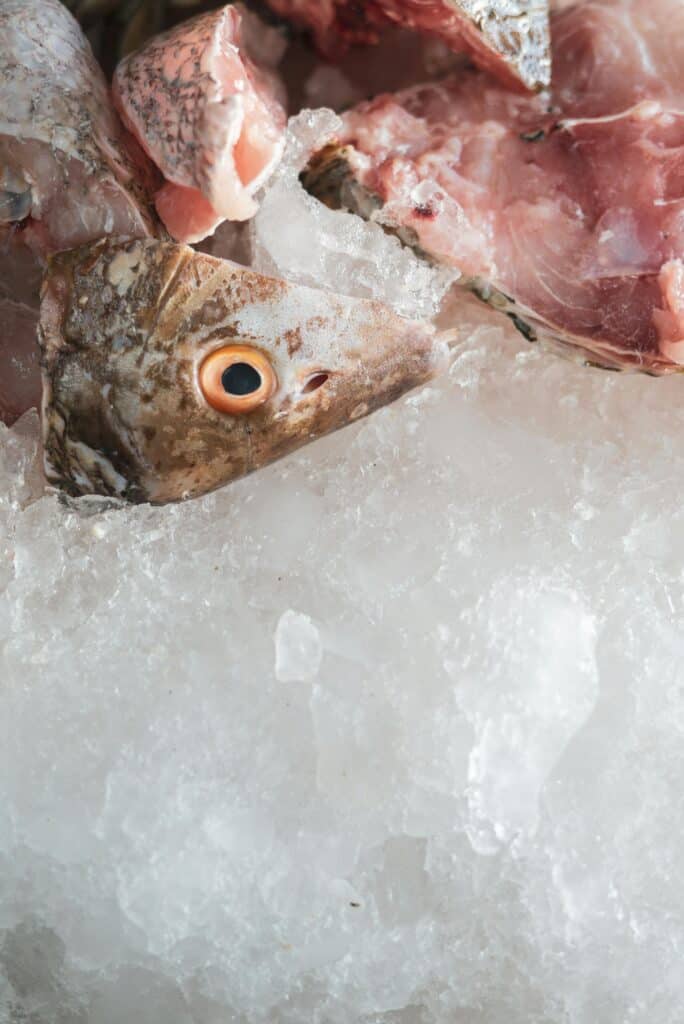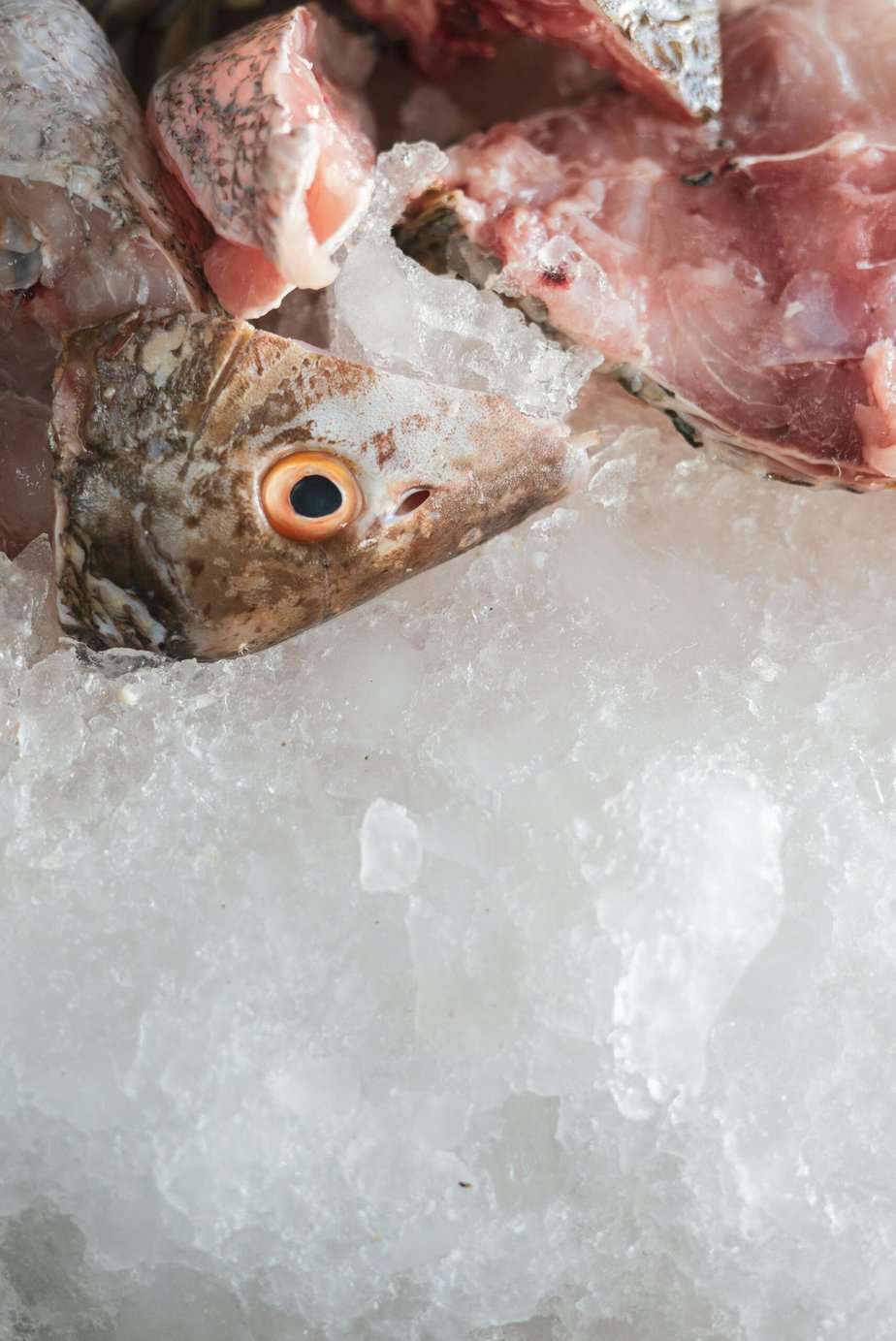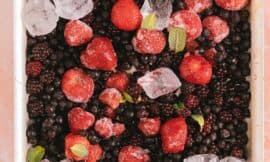Frozen food provides a variety of choices, from colorful fruits and vegetables to various meats and ready-to-go meals, ensuring your kitchen is equipped to handle any meal plan with ease. The benefits of frozen fare are particularly noticeable when fresh options are limited or when time constraints make meal prep a challenge. This guide focuses on the essential techniques on how to cook frozen food, allowing you to enjoy wholesome, tasty dishes quickly, regardless of the season or your busy schedule.
Our expertise in the kitchen extends to unlocking the flavors and textures from foods preserved through freezing. It is essential to approach frozen food with strategies that retain its quality while ensuring tasty outcomes. Safety is paramount; thus, we’re steadfast about the practices that ensure our food is not only delicious but also safe to consume.

Key Takeaways on How to cook frozen food
- Cooking frozen food combines ease and nutrition for efficient meal preparation.
- Mastery of proper techniques enhances flavor and preserves quality.
- Safety measures are critical to ensure the wholesome consumption of frozen foods.
Different ways on how to cook frozen food
Here’s some of different ways to cook frozen food:
- Microwave Cooking: For a quick and convenient option, microwave single-serve frozen meals or snacks according to the package directions. This method is perfect for those who want a fast meal with minimal effort. (LinkedIn)
- Oven Baking: Preheat your oven and bake frozen pre-made dishes like lasagnas, casseroles, or pies. Ensure you follow the instructions on the packaging for the best results. This method is great for a crispy and evenly cooked finish.
- Stovetop Sautéing or Stir-Frying: Some frozen foods like vegetables or shrimp can be cooked directly in a sauté pan or wok. Add a little oil to the pan, and cook the food over medium-high heat until thoroughly heated and possibly browned.
- Boiling: This method works well for frozen dumplings, ravioli, or vegetables. Bring a pot of water to a boil, add the frozen food, and cook until done. It’s simple and doesn’t require added fats.
- Steaming: Retain the nutrients and flavors of frozen vegetables by steaming them. Use a steamer basket over a pot of boiling water, and steam until the vegetables are tender.
- Grilling: Yes, you can grill certain frozen foods! Thicker items like frozen burger patties or vegetables can go straight from the freezer to the grill. Just remember to adjust cooking times accordingly.
- Slow Cooking: Some frozen foods can be added directly to a slow cooker. This is ideal for frozen meat stews or soups. Combine with other ingredients and let it cook for several hours for a hearty meal.
- Air Frying: An air fryer can cook frozen foods like French fries, chicken wings, or fish sticks to crispy perfection. No need to thaw—just place them in the air fryer basket and cook according to the appliance’s instructions.
Remember, regardless of the method you choose, always ensure that your food reaches the safe internal temperature recommended for consumption.
Understanding Frozen Foods
When we discuss cooking frozen food, it’s important to recognize the unique properties and advantages that freezing provides, including food safety preservation and reduction in food waste. We’ll also cover how to identify high-quality frozen products.
Characteristics of Frozen Foods
Frozen foods have a distinct set of characteristics that affect how they should be cooked. Firstly, frozen meals and frozen vegetables are generally blanched before freezing, which means they’ve been partially cooked. This process helps retain nutritional value and texture. Additionally, freezing food creates ice crystals within the fibers of the food, which can affect the texture once thawed; thus, knowing the proper method to cook them is key to preserving their quality.
Benefits of Freezing Food
Freezing food provides several benefits:
- Safety: By freezing food, we slow down enzyme activity and microbial growth that can cause food spoilage and illness. In essence, freezing acts as a pause button, extending shelf life remarkably well.
- Reduction in Food Waste: Freezing allows us to store food for extended periods without a significant loss of quality, helping to reduce food waste. It’s a practical way to preserve seasonal produce or take advantage of bulk purchasing.
Selecting Quality Frozen Foods
To ensure we get the best out of our frozen food, it’s crucial to select high-quality products. Here’s what to look for:
- Packaging: Choose items with intact packaging, free from any signs of frost or ice crystals, which might indicate the food has been thawed and refrozen.
- Ingredients: For healthier options, look for frozen foods with a short ingredient list, emphasizing whole foods over additives.
- Expiration Dates: Always check the ‘use by’ or ‘best before’ dates to ensure you’re getting the freshest frozen options available.
Cooking methods and tips for various types of frozen food
Below is a comprehensive table on different cooking methods on various types of frozen food as well as instructions and expert tips:
| Cooking Method | Type of Frozen Food | Instructions | Tips |
|---|---|---|---|
| Microwave | Single-serve meals, vegetables, soups | Follow package directions for power level and time. | Stir halfway through cooking for even heat distribution. |
| Oven Baking | Pizzas, casseroles, fries | Preheat oven to the temperature stated on the package. Place food on a baking sheet and bake until golden brown. | Use a preheated baking tray for extra crispiness. |
| Stovetop | Stir-fry mixes, burger patties, dumplings | Heat oil in a pan, add frozen food, and cook on medium-high until thoroughly heated. | Cover the pan to speed up cooking and ensure even heat. |
| Boiling | Pasta, vegetables, hot dogs | Bring water to a boil, add frozen food, and cook for the recommended time. | Add salt to the water to enhance flavor. |
| Steaming | Vegetables, fish fillets | Fill a pot with a few inches of water, place a steamer basket with food above water, cover, and steam until cooked. | Season the water with herbs for additional flavor. |
| Grilling | Burgers, steaks, vegetables | Preheat grill to medium-high, place frozen food on the grill, and cook until desired doneness. | Brush food with oil to prevent sticking and add flavor. |
| Slow Cooking | Stews, chili, roasts | Place frozen food in the slow cooker with other ingredients and cook on low for 6-8 hours or high for 3-4 hours. | Trim excess fat from meats to prevent greasiness. |
| Air Frying | Chicken wings, fries, egg rolls | Preheat air fryer, place frozen food in the basket, and cook at the temperature and time directed. | Shake the basket occasionally for even cooking. |
Preparation Basics
When we prepare frozen foods, it’s crucial to handle frozen food correctly and achieve the best possible flavor and texture. We’ll discuss the proper methods to thaw, season, and preheat before cooking.
Thawing Frozen Food
Thawing is the first step we take to bring frozen food to a cookable state. There are a few safe methods we can use:
- Refrigerator: Transfer the food from the freezer to the refrigerator and allow it to thaw slowly. Defrosting using refrigerator keeps the food at a safe temperature during the process.
- Cold Water: Place the food in a leak-proof bag and submerge it in cold tap water, changing the water every 30 minutes.
- Microwave: Use the defrost setting on our microwave when we’re short on time. Defrosting using microwave requires us to cook the food immediately after thawing.
Using a food thermometer, we can check if the food is thawed by ensuring it’s reached a temperature above 32°F (0°C) before cooking.
Seasoning and Preparing for Cooking
After defrosting, we need to properly season our food which can enhance its flavor. If we are working with pre-cooked food, a gentle seasoning is often enough. In contrast, raw frozen food may require a more robust blend of spices or a marinade for enhanced flavor. Always pat the food dry before applying seasonings to ensure they adhere better.
Preheat Your Appliance
Preheating our appliance, whether it’s an oven, skillet, or grill, is essential. This step ensures that our food starts cooking at the right temperature as soon as it hits the pan or rack. Here’s a quick reference for preheating temperatures:
| Appliance | Preheat Temperature |
|---|---|
| Oven | 350-450°F (177-232°C) |
| Skillet | Medium-High Heat |
| Grill | 400-450°F (204-232°C) |
Cooking Techniques for frozen food
In this section, we dive into the optimal ways to cook frozen food, focusing on techniques that maximize flavor and ensure food safety. We’ll discuss the importance of cooking times, correct temperatures, and the use of tools like food thermometers to achieve the best results.
Baking Frozen Foods
Baking is a reliable method for cooking frozen food, from vegetables to proteins. We use a preheated oven, typically ranging between 350°F to 425°F, and arrange the food in a single layer on a baking sheet to ensure even cooking and crispiness. It’s crucial to refer to the food’s packaging for the exact temperature and cooking time. By using a food thermometer, we can ensure the internal temperature is appropriate for safe consumption.
Frying and Sautéing
When we sauté or fry frozen food, it’s important to use the right amount of oil in a skillet to prevent sticking and achieve a golden-brown exterior. We avoid overcrowding the pan and might need to adjust the heat to accommodate extra liquid that frozen foods release. Safely cook frozen foods in a frying or sautéing method by attaining a safe internal temperature, as per food safety guidelines.
Using an Air Fryer or Convection Oven
The use of an air fryer or convection oven is effective for cooking frozen food because they circulate hot air around the food, yielding a crispy texture similar to frying without the excess oil. We make sure to spread the frozen food in the basket in a single layer. The cooking time is usually quicker compared to traditional ovens, so we monitor closely to avoid overcooking.
Grilling Frozen Goods
Grilling is a less common technique for frozen foods but can be done successfully. We ensure the grill is preheated to a consistent temperature and typically use a lower temperature setting as compared to fresh foods to avoid burning the exterior before the middle is sufficiently thawed and cooked. We always use a food thermometer to check that our grilled foods reach a safe internal temperature.
Safety and Doneness of frozen food
Ensuring the safe consumption of frozen foods involves careful attention to both the prevention of foodborne illness and the accurate assessment of doneness through reliable methods. Our focus is on reducing risks and achieving the desired culinary results.
Avoiding Foodborne Illnesses
To prevent foodborne illnesses, it is crucial to follow food safety guidelines. This means handling frozen food properly to avoid cross-contamination, which can occur when juices from raw meats contact other foods. Always wash hands, utensils, and surfaces after they have been in contact with raw meat. Remember that the USDA and FDA websites offer current recommendations and any news on recalls that could affect food safety.
- USDA Food Safety Guidelines: Visit the USDA
- FDA Food Safety Information: Go to the FDA
Using Food Thermometers
We advocate the use of a food thermometer to precisely verify internal temperatures, as this is the only reliable method to ensure food has been cooked enough to kill harmful bacteria. Every type of meat has its prescribed safe-to-eat internal temperature:
- Poultry: 165°F
- Ground meats: 160°F
- Beef, Veal, Lamb (steaks, roasts): 145°F
When reheating, also ensure that frozen food reaches 165°F to maintain safety.
Understanding Doneness
Doneness should not be guessed by color or texture, especially since partially cooked or “ready-to-cook” products can mislead with appearances. Instead, familiarize yourself with the proper cooking times and internal temperatures necessary for various meats. For example, chicken breasts are safe at 165°F, while pork needs to reach between 145°F and 160°F, depending on the cut. Recognize that “doneness” is not just about taste or texture.
Testimonials from Users on How to cook frozen food
Cooking frozen food has never been easier, thanks to the experiences shared by our users. Sarah from New York found that baking frozen vegetables at 425°F for 20 minutes with a dash of olive oil and seasoning brought out their natural flavors, making them a hit with her family. John in California swears by his air fryer for crispy frozen fries in just 15 minutes, a game-changer for quick, delicious meals. These real-life applications show that with the right techniques, frozen food can be transformed into nutritious and tasty dishes, perfect for busy lifestyle
Nutrient Preservation studies in frozen food
Here are more studies related to the nutritional preservation in frozen food cooking:
| Study Summary | Link |
|---|---|
| This study compares the vitamin retention in eight different fruits and vegetables stored under refrigerated and frozen conditions. It highlights the effectiveness of freezing in preserving essential nutrients. | Link to Study |
| Examines mineral, fiber, and total phenolic retention in fruits and vegetables under refrigerated and frozen storage, offering insights on how these key nutrients are affected. | Link to Study |
| Discusses the impact of open-sun drying and solar-dryers on beta-carotene and vitamin C content in fruits and vegetables, providing a comparison with frozen storage methods. | Link to Study |
| Investigates the effects of storage under ambient conditions on the vitamin content of dehydrated vegetables, highlighting the importance of proper storage techniques. | Link to Study |
| Reviews advanced preservation methods and their impact on nutrient retention in fruits and vegetables, emphasizing the role of freezing in maintaining nutritional quality. | Link to Study |
| Reviews effects of pretreatments on quality attributes of long-term deep-frozen storage of vegetables, focusing on how pretreatments can enhance nutritional preservation. | Link to Study |
These studies provide a comprehensive overview of how different storage and preservation methods impact the nutritional quality of fruits and vegetables.
Frequently Asked Questions and answers on How to Cook Frozen Food
- Can I cook frozen food without thawing it first?
- Yes, many frozen foods can be cooked directly from the freezer, including vegetables, meats, and pre-made meals. Adjust cooking times as needed since frozen foods typically take longer to cook.
- How do I prevent frozen meat from becoming dry when cooking?
- To keep frozen meat from drying out, cook it using methods that retain moisture, such as braising, slow cooking, or using a sauce. Also, avoid overcooking by checking the internal temperature with a meat thermometer.
- Can I fry frozen food in oil?
- Yes, certain frozen foods like French fries and breaded shrimp can be fried in oil. Make sure the oil is at the correct temperature and avoid overcrowding the pan to ensure even cooking.





